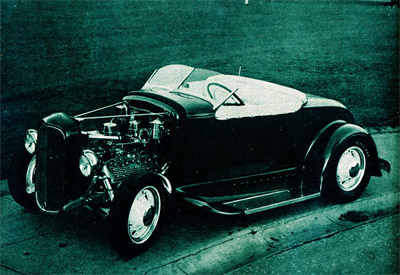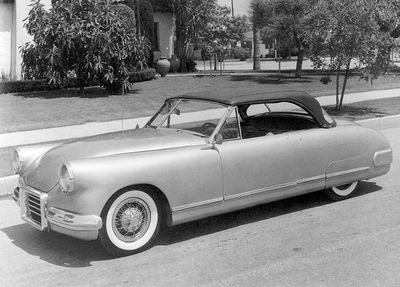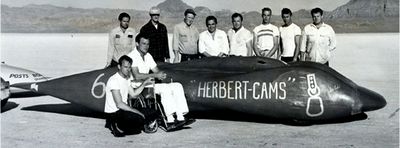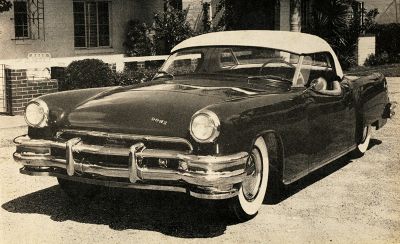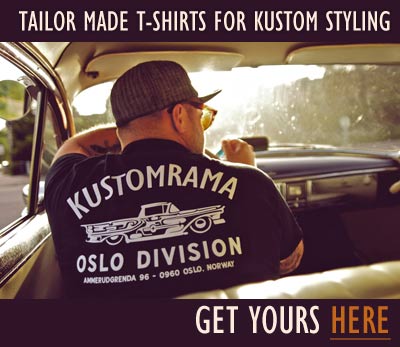1952
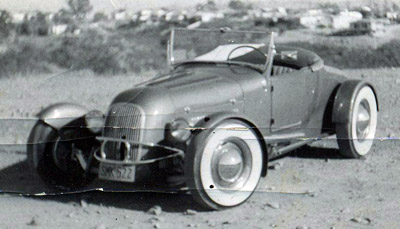



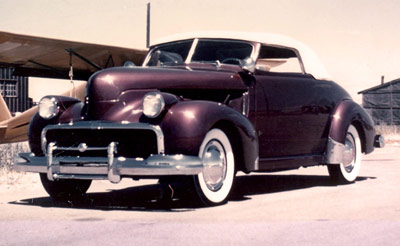

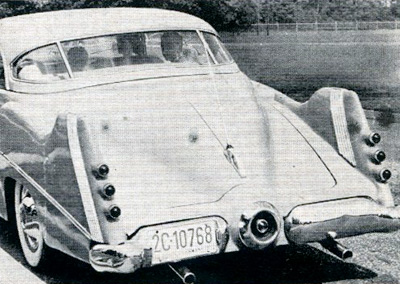




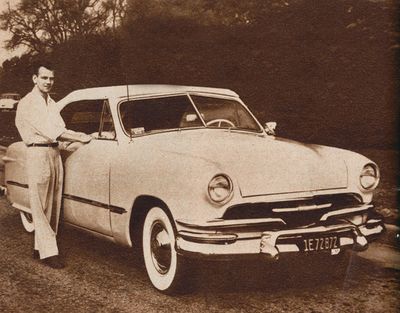


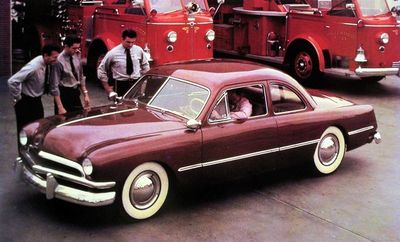


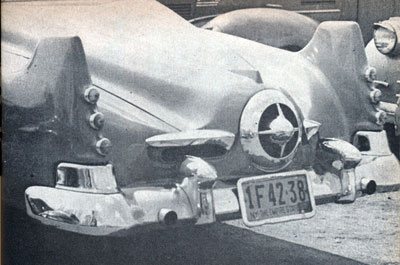
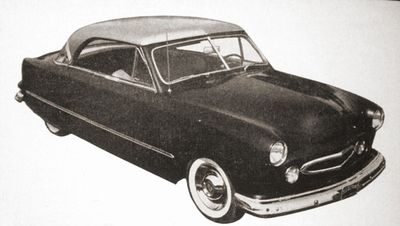
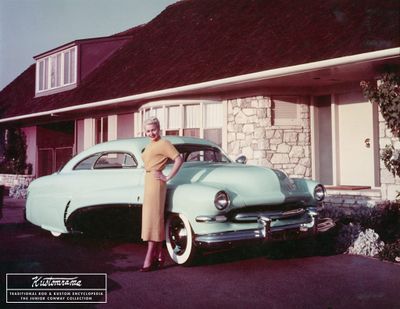
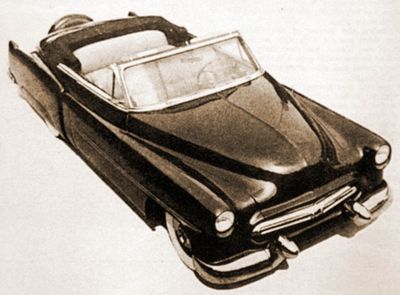


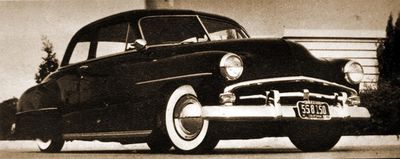
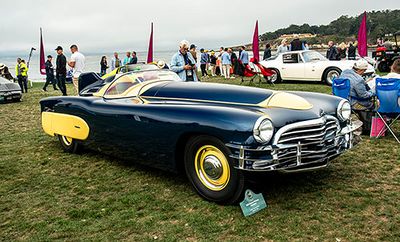



By 1952, customizers were refining their craft with understated, classy modifications, often borrowing cues from European sports cars. Valley Custom Shop set a perfect example with Ron Dunn’s 1950 Ford, sectioned and fitted with radiused wheel wells. Rather than going for radical show-car flair, Dunn’s Ford exuded a refined, near-factory elegance, a trend that resonated with many builders seeking sleek yet streetable customs.
Contents
- 1 The Sports Custom Craze
- 2 The 1951 GM LeSabre
- 3 North vs. South: Barris vs. Bailon
- 4 The Hirohata Merc Debuts
- 5 Other Notable Events
- 6 Hot Rods Built or Completed in 1952
- 7 Custom Cars Restyled or Completed In 1952
- 8 Sport Custom Built or Completed in 1952
- 9 Hot Rod and Custom Car Clubs Established in 1952
- 10 Custom Car and Hot Rod Show of 1952
- 11 Timing Associations Established in 1952
- 12 Salt Flat Races Held in 1952
The Sports Custom Craze
At the same time, a new movement was brewing: the Sport Custom. With British sports cars like the Jaguar XK-120 out of reach, enthusiasts built homegrown versions by piecing together mechanical components from aging Fords or Hudsons and reshaping them into open-top, roadster-like bodies. One pioneer was Charles Martz of Aurora, Montana, who merged a 1940 Hudson sedan and an ambulance to create a buttercup-yellow Sport Custom featured on the cover of Motor Trend January 1952. Martz even wrote a book titled Build Your Own Custom Sports Car, helping to popularize the concept nationwide.
The 1951 GM LeSabre
Sport Customs were typically larger and more powerful than their imported counterparts but often lacked the nimble handling of a true sports car. They peaked in popularity during the mid-1950s, and while most were cut-down coupes or sedans, some builders fabricated entirely new bodies from metal or fiberglass. Ironically, these backyard sport customs both influenced and were influenced by Detroit’s show cars. The 1951 GM LeSabre, designed by Harley Earl, was one of the era’s most copied concept vehicles. Featuring aircraft-inspired styling, fins, and a futuristic silhouette, it left a strong impression on builders looking for something more exotic than a typical mild custom. Its sleek lines found their way into countless early-1950s homebuilt roadsters and customs.
North vs. South: Barris vs. Bailon
By 1952, George Barris of Barris Kustoms had earned a reputation as Southern California’s leading custom car builder. But at the 3rd Annual National Roadster Show, a formidable new challenger emerged from the north; Joe Bailon of San Leandro. The show would mark the beginning of a fierce rivalry between two of the most talented customizers in the country, and one of the most exciting showdowns in early custom car history.[1]
According to show manager Mary L. Slonaker, the fiercest competition that year was expected between the Kustoms of Los Angeles, led by Barris, and the newly rising Customs of San Leandro, under the leadership of Bailon. The contest quickly took on the feel of a North vs. South California rivalry. Bailon’s team arrived with five standout entries, including his own radically customized 1941 Chevrolet. Meanwhile, Barris had multiple contenders on display, among them Anthony Heinsbergen’s Muntz Jet and Jim Skonzakes’ 1949 Buick.[1]
Skonzakes' Buick, driven all the way from Dayton, Ohio, became one of the most talked-about cars of the show. Representing the East Coast in the competition for the first-ever “Car of Elegance” award, Jim’s journey to Oakland was almost as legendary as the car itself, he was rerouted by snow and floods, blew three tires, and even hit a cow on the 3,500-mile trek west. His entry, built by Barris Kustoms, stood alongside other top customs from across the country, including The Sloan Special from the Portland Auto Show.
Despite the strong national presence, the local spotlight remained fixed on Bailon's Chevy, which press and spectators alike quickly nicknamed The Dashboard due to its extravagant interior. The car featured a $1,160 hand-built dashboard with 15 gauges, 32 push buttons, a custom steering post, and even a built-in cocktail bar. It was a rolling showcase of Bailon’s vision and craftsmanship, and it captured the judges’ attention.[1]
Press coverage noted that the entries from Barris and Bailon would “match the bodywork of two nationally recognized leaders in custom construction,” and The Oakland Tribune reported that Barris had “assumed a stature as a target for other custom body designers to shoot at.” In 1952, it was Joe Bailon who took the shot and hit the mark.[1]
Bailon's 1941 Chevrolet won the first-ever National award at the Oakland Roadster Show, beating out the field and solidifying his place among the elite customizers of the era. Later renamed Miss Elegance, the car became Bailon’s breakout creation and a symbol of Northern California's arrival on the custom car scene. At the time, Bailon operated Bailon's Body Shop at 15960 East 14th Street in San Leandro, located across from the Oakland Speedway. The win marked the beginning of a celebrated career and one of the defining rivalries of the golden age of custom cars.[1]
The Hirohata Merc Debuts
Yet 1952’s biggest head-turner was the Hirohata Merc, destined to become the most famous custom of the classis era. Built by George and Sam Barris, it borrowed the curved hardtop window design first seen on Nick Matranga’s 1940 Mercury but pushed the concept further with a bold sea foam and organic green two-tone paint scheme. Wherever it appeared, crowds gathered, proving that even in a year of subtle elegance and sports car influences, radical innovation still had a place. The scene was expanding, showing that the custom car movement had room for both refined restraint and boundary-pushing creativity.
Other Notable Events
- In 1952, Gene Ohly began working for Evans Equipment.
- Nick Matranga's 1940 Mercury was totaled in 1952.
Hot Rods Built or Completed in 1952
Louis Banto and Jack Perre's 1927 Ford Model T Roadster
Paul Sylva's 1927 Ford Model T Roadster
Buzz DeChamp's 1931 Ford Model A Roadster
Bill Jerry's 1932 Ford Roadster
Doug Hartelt's 1934 Ford 3-Window Coupe
Custom Cars Restyled or Completed In 1952
Doug Rice's 1939 Ford Coupe
Fred Crellar's 1940 Chevrolet Convertible
Dick Brooks' 1940 Ford Convertible
Jack T. Chandler's 1941 Ford
Tommy Thornburgh's 1947 Studebaker Champion Convertible
Robert Mooselli's 1948 Mercury
Gene Schilling's 1949 Chevrolet Convertible
Spencer Murray's 1949 Chevrolet
Bill Irwin's 1949 Ford Convertible
Michael Violante's 1949 Ford Convertible
Warren Dorrill's 1949 Ford - The Shark
Louie Bettancourt's 1949 Mercury
Ron Dunn's 1950 Ford - The Monte Carlo
Buddy Alcorn's 1950 Mercury
Don Pulford's 1950 Mercury
Wally Troy's 1950 Oldsmobile Convertible - The Troy Special
Pete Chiello's 1951 Ford Victoria
Bob Hirohata's 1951 Mercury - The Hirohata Merc
Frank Airheart's 1951 Oldsmobile 98 Convertible
Nick Cozzitorto's 1952 Ford F-1 Pickup
Freddy Martin's 1952 Muntz Road Jet
Anthony Heinsbergen's Muntz
Chet Herbert's Beast III
Clark Gable's 1952 Jaguar XK 120
Emory Bozzani's 1952 Plymouth Sedan
Sport Custom Built or Completed in 1952
1952 Fageol Pataray Roadster
The Donz Lancer
Hot Rod and Custom Car Clubs Established in 1952
Aces
Bearing Busters of Berwyn
Cam Snappers of Newburyport
Motor Masters
Road Kings of Burbank
Swanx of Oakland
Custom Car and Hot Rod Show of 1952
Pasadena Auto Show and Reliability Run
Timing Associations Established in 1952
Kansas City Timing Association
Salt Flat Races Held in 1952
Did you enjoy this article?
Kustomrama is an encyclopedia dedicated to preserve, share and protect traditional hot rod and custom car history from all over the world.
- Help us keep history alive. For as little as 2.99 USD a month you can become a monthly supporter. Click here to learn more.
- Subscribe to our free newsletter and receive regular updates and stories from Kustomrama.
- Do you know someone who would enjoy this article? Click here to forward it.
Can you help us make this article better?
Please get in touch with us at mail@kustomrama.com if you have additional information or photos to share about 1952.
This article was made possible by:
SunTec Auto Glass - Auto Glass Services on Vintage and Classic Cars
Finding a replacement windshield, back or side glass can be a difficult task when restoring your vintage or custom classic car. It doesn't have to be though now with auto glass specialist companies like www.suntecautoglass.com. They can source OEM or OEM-equivalent glass for older makes/models; which will ensure a proper fit every time. Check them out for more details!
Do you want to see your company here? Click here for more info about how you can advertise your business on Kustomrama.
